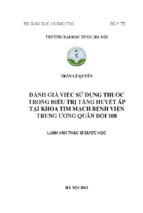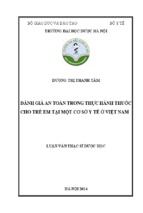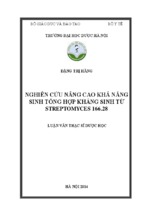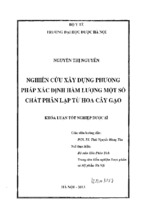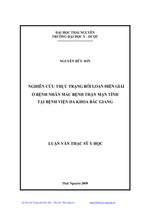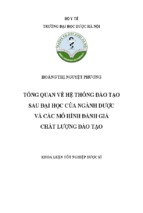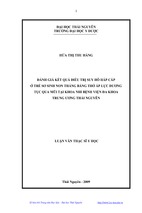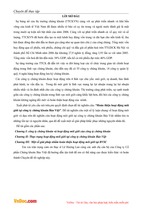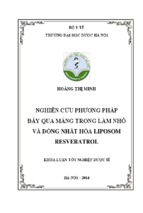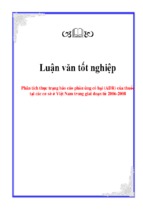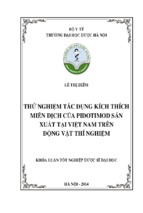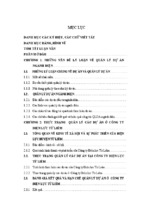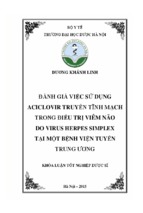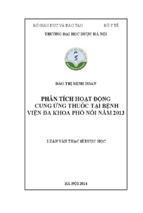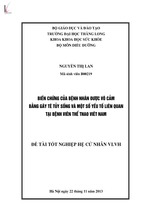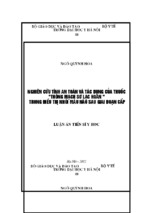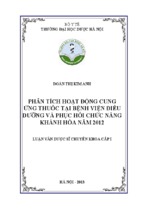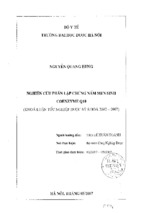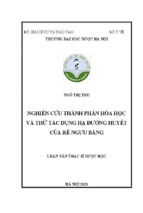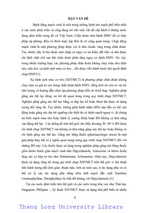CORPORATE SOCIAL RESPONSIBILITY IN VIET NAM: A STUDY OF
STAKEHOLDERS’ PERCEPTIONS OF CORPORATE SOCIAL
RESPONSIBILITY.
BY
PHAM VAN THUAN
Graduation Project Submitted to the Department of Business Studies, HELP
University College, in Partial Fulfillment of the Requirements for the Degree of
Bachelor of Business (Accounting) Hons
i
October 2010
Declaration of Originality and Word Count
DECLARATION
I declare that this graduation project is based on my original work except for quotations
and citation which have been duly acknowledged. I also declare that it has not been
previously or concurrently submitted for any other courses/degrees at HELP University
College or other institutions.
Word Count: …. Words.
Pham Van Thuan
Date
ii
Abstract
CORPORATE SOCIAL RESPONSIBILITY IN VIET NAM: A STUDY OF
STAKEHOLDERS’ PERCEPTIONS OF CORPORATE SOCIAL
RESPONSIBILITY.
BY
PHAM VAN THUAN
October 2010
Supervisor: Dr. Nguyen Thi Phuong Hoa
Corporate Social Responsibility has developed through the long history and it is also
expected to be implemented by any business entities in the world. It is no longer a new
term for developing countries such as Viet Nam. However, in recent year, when the
economic is opened, there are a lot of scandals and critical cases concerning about the
Corporate Social Responsibility and ethical business as the result of the economic boom.
So, there appear a lot of researches on that field; however the understanding of
Corporate Social Responsibility is limited in Viet Nam. Therefore, it may be a result of
motivation for the researcher to conduct the survey about the perceptions of CSR among
Vietnamese individual investors in TL Securities Company’s office (TLS).
In this study, the researcher aims at assessing the understanding of Vietnamese
individual investors on the topics of CSR. Further more, the researcher tries to define
three factors which contribute to the CSR perceptions namely CSR awareness,
investment decision and CSR reporting base on the understanding and opinion of the
investors.
iii
By conducting the research, the research is able to indicate that the understanding of
CSR concepts and its perceptions is limited; because the investors have little basic
knowledge about the CSR. So, investors in Viet Nam are very hard to use CSR
information as a tool to value firm and it is also difficult for them to make investment
decision.
iv
Table of contents
Declaration of Originality and Word Count ..................................................................... ii
DECLARATION ............................................................................................................. ii
Abstract ............................................................................................................................ iii
Table of contents ................................................................................................................ v
List of Figures and Tables .............................................................................................. viii
List of Abbreviations.........................................................................................................ix
CHAPTER 1: INTRODUCTION ...................................................................................... x
1.1
Research Background ...................................................................................... 1
1.1.1 CSR in the world ............................................................................................... 1
1.1.2 CSR in Vietnam ................................................................................................ 1
1.2
Problem Statement ........................................................................................... 3
1.3 Objectives and Sphere of Research ...................................................................... 4
1.3.1 Objectives of Research ...................................................................................... 4
1.3.2 Sphere of Research ............................................................................................ 5
1.4 Research Methods .................................................................................................... 5
1.5 Structure of Research ............................................................................................... 6
CHAPTER 2: LITRERATURE REVIEW .................................................................... 7
2.1.3
Investment Decision ................................................................................... 7
2.2.1 Business Ethics in Viet Nam – Reality and Solutions ...................................... 7
2.2.2 CSR in business entities in Viet Nam – Reality and Solutions ......................... 7
2.2.3 CSR – The Investors’ Perspective..................................................................... 7
2.2.4 CSR, PR of Foreign-Invested Companies ......................................................... 7
2.3 Researches Summary ............................................................................................... 7
v
2.1 Research’s related concepts .................................................................................. 8
2.1.1
Carroll's 1979-1991 conceptualization....................................................... 9
2.1.2
Stakeholder theory ................................................................................... 11
2.1.3
Investment Decision ................................................................................. 12
2.1.4 Responsible Investment .................................................................................. 13
2.1.5 Investor Relation ............................................................................................. 13
2.1.6 CSR Reporting ................................................................................................ 14
2.1.7 CSR practice and challenges ........................................................................... 16
2.2 Researches and Studies .......................................................................................... 18
2.2.1 Business Ethics in Viet Nam – Reality and Solutions .................................... 18
2.2.2 CSR in business entities in Viet Nam – Reality and Solutions ....................... 19
2.2.3 CSR – The Investors’ Perspective................................................................... 20
2.2.4 CSR, PR of Foreign-Invested Companies ....................................................... 21
2.3 Researches Summary ............................................................................................. 22
CHAPTER 3: RESEARCH METHODOLOGY ............................................................. 25
3.1 Research Objectives ............................................................................................... 26
3.2 Theoretical Framework and Measurement............................................................. 26
3.2.1 CSR perceptions .............................................................................................. 27
3.2.2 CSR Awareness ............................................................................................... 27
3.2.3 Investment Decision ........................................................................................ 28
3.2.4 CSR Reporting ................................................................................................ 28
3.3 Measurement and Quality Design .......................................................................... 28
3.3.1 Section 1 .......................................................................................................... 29
3.3.2 Section 2 .......................................................................................................... 29
3.3.2.1 CSR Awareness ........................................................................................ 30
vi
3.3.2.2 Investment Decision ................................................................................. 31
3.3.2.3 CSR Reporting ......................................................................................... 31
3.4 Research Method .................................................................................................... 32
3.4.1 Sampling ......................................................................................................... 33
3.5 Hypothesis Statement ............................................................................................. 33
3.5.1 Correlation of Independent Variable ............................................................... 34
CHAPTER 4: RESULT ANALYSIS .............................................................................. 35
4.1 Collection of Questionnaires .............................................................................. 36
4.2 Description of Result.............................................................................................. 36
4.2.1 Age .................................................................................................................. 36
4.2.2 Gender ............................................................................................................. 37
4.2.3 CSR Awareness ............................................................................................... 38
4.2.4 Investment Decision ........................................................................................ 42
4.2.5 CSR Reporting ................................................................................................ 46
4.3 Result Analysis ...................................................................................................... 48
4.3.1 Hypothesis 1 .................................................................................................... 49
4.3.2 Hypothesis 2 .................................................................................................... 51
4.3.3 Hypothesis 3 .................................................................................................... 52
CHAPTER 5: CONCLUSION AND RECOMENDATION ........................................... 53
5.1 Conclusion ............................................................................................................. 54
5.2 Recommendation.................................................................................................... 55
5.3 Limitation of Study ................................................................................................ 56
5.4 Suggestion for Future Research ............................................................................. 57
Reference (Harvard referencing system) ......................................................................... 58
APPENDICES ................................................................................................................. 61
vii
List of Figures and Tables
Table 1: Researches and Studies Summary ..................................................................... 24
Table 2: Age ..................................................................................................................... 36
Table 3: Gender ................................................................................................................ 37
Table 4: Question 1 - Result and Analysis ....................................................................... 38
Table 5: Question 2 - Result and Analysis ....................................................................... 39
Table 6: Question 3 - Result and Analysis ....................................................................... 40
Table 7: Question 4 - Result and Analysis ....................................................................... 41
Table 8: Question 5 - Result and Analysis ....................................................................... 42
Table 9: Question 6 - Result and Analysis ....................................................................... 43
Table 10: Question 7 - Result and Analysis ..................................................................... 44
Table 11: Question 8 - Result and Analysis ..................................................................... 45
Table 12: Question 9 - Result and Analysis ..................................................................... 46
Table 13: Question 10 - Result and Analysis ................................................................... 47
Table 14: Question 10 - Result and Analysis ................................................................... 48
Table 15: Hypothesis 1..................................................................................................... 49
Table 16: Hypothesis 2..................................................................................................... 51
Table 17: Hypothesis 3..................................................................................................... 52
viii
List of Abbreviations
FPTS
FPT Securities Company
CSR
Corporate Social Responsibility
RI
Responsible Investment
IR
Investor Relations
WTO
World Trade Organization
VCCI
Viet Nam Chamber of Commerce and Industry
NIRI
National Investor Relations Institute
PR
Public Relations
ix
CHAPTER 1: INTRODUCTION
1.1 Research Background
1.1.1 CSR in the world
1.1.2 CSR in Vietnam
1.2 Problem Statement
1.3 Objectives and Sphere of Research
1.3.1 Objectives of Research
1.3.2 Sphere of Research
1.4 Research Methods
1.5 Structure of Research
x
1.1 Research Background
1.1.1 CSR in the world
Corporate Social Responsibility (CSR) is a hot subject for many researchers in the world.
In many researches, researchers recognize that many companies have been paying a lot of
money to have a good business systems and became has responsible to the society as the
whole. In order to do that, so many programs have been done in order to make good
things for the society such as saving energy, reducing carbon emission, school building,
improve drinking waster supply, etc. Specially, a big retailer of consumer electronics in
Canada and USA of Best Buy Co., Inc has a good recycle program. The Deputy Manager
of public relations of this company has been said that “We only feel that we will succeed
in the market if we take responsibilities for society” (Saga Vietnam, 2008). Other
example is Starbucks known as a world-wide coffee company, which has many good
activities to make excellent community. The other good actions have done by the World
Bank and Merck Pharmacy Company. They also paid more than 50 millions into give
free Mectizan medicine to help poor people in 28 countries in Africa (Saga Vietnam,
2008). Furthermore, there are a lot of companies in the world have been produced in the
way of protecting the environment or making useful products for customers and
developing of community and society.
1.1.2 CSR in Vietnam
In this study, the author recognizes that Corporate Social Responsibility (CSR) is a new
concept in Viet Nam; because of limited understanding of directors’ on the CSR
information used in business. Therefore, international organizations have introduced CSR
under the form of Code of Conduct or social standard requirements for Vietnamese
1
businessmen. According to Professor André Schmitt, Director of CFVG, “Current
financial crisis show that the Vietnamese Economy was depended on supply chains of the
world. Vietnam Economy can not evade the global competitive pressures. Thus, the task
of implementing CSR is as difficult as it is in any developed countries” (CSR Vietnam
Forum, 2009).
Furthermore, with the big and important event that Vietnam joint to the World Trade
Organization (WTO) in 2007, CSR became more important to the companies in Viet
Nam because of strict requirements from their partners and foreign clients in the world
(WTO website, 2006). Therefore, since the year 2005, the Viet Nam Chamber of
Commerce and Industry (VCCI) has been made a program about “CSR – towards the
sustainable development” in order to support companies in Viet Nam to implement CSR
actively in the international economic integration circumstances. According to Dr. Doan
Duy Khuong, the vice-chairman of VCCI, “CSR is a requirement for the companies and
they could not reach the international market without CSR implementation” (Securities
Investment Newspaper, 2008). However, in the fact it is observed that these companies in
Viet Nam face many difficulties in applying the CSR programs because of limited their
understanding and perception about CSR or because of the lack of financial and technical
resources. It is also difficult for small-size companies to apply the CSR. In order to
illustrate in this issue, the researcher provide some examples. There is one firm that has
been made pollution in a river in Viet Nam and it has been caught by the Vietnamese
government. In order to explain about its issue, the company said that its actions were to
help the company avoid bankruptcy after the recent economic crisis. And, the question
was asked if it is the end of implementation of CSR activities? somebody such as
2
directors have been think of that way; however, if the firms want to develop in the longterm basis, they should follow the CSR requirement in the way that they should have
been responsible to the society. From that, we can see which companies have been cares
much about CSR activities under the financial crisis period.
1.2 Problem Statement
Now a day, CSR is known as a very hot issue in Viet Nam as in the world. It is also
requirement not only from the business but also from the stakeholders such as the
government, investors and so on. In recent years, Viet Nam is knows as the fastestgrowing economy in the world. Therefore, CSR becomes an important factor to develop
sustainable business. In order to do this, the businessmen do not only care much about
how to make profit but also they care about CSR activities. Besides, the government also
has many awards for companies having good CSR activities such as CSR Viet Nam
Award (Saigon Businessman, 2009). From that, there are a lot of companies having
actions related to CSR activities such as paying a lot of money in order to help the poor
and disadvantaged persons.
However, there are some companies having wrong-doing things which have been found
out in recent time. The worst case is the Taiwan-owned company named as Vedan
International. It’s conducted bad action that discharged directly waste water in to the Thi
Vai River in Dong Nai province. Before this action was discovered, the company also
used two pumping systems in its factory. One system was directly through refining
process; however it is never used if using when have coming of the supervision from the
local government office. And, one the other system was discharging waste water in to the
river (Invest in Vietnam, 2008). This action of the company has serious effects on the
3
environment and people in this place. Another case related with CSR issue is Taiwaneseowned Company in Quang Minh industrial zone. It has been found that the company also
was discharging waste water into river. After being discovered, the firm’s deputy director
general Mr. Liu Chien Lin has been explained for that the company’s action was to help
the company over the financial crisis. In the statistics, the firm has been saved around
US$4,209-5,261 a month by doing this action (Thanh Nien News, 2010).
As the result of these issues above, the people recognize that as the serious problems
from those companies above and they are also rejecting to use or by the product from
those companies. That can lead to bad affects not only of the firms, shareholders and
stakeholder but also reducing the profits of investors. Therefore, with the understanding
of CSR concepts, theories, and perceptions of investors are important to them before they
want to invest in the companies. In this study, the researcher also wants to access the
understanding of individual investors in CSR perceptions and so on.
1.3 Objectives and Sphere of Research
1.3.1 Objectives of Research
In order to do the thesis, the researcher focuses on:
- Definitions and summarize the CSR concepts and other theory relative.
- Investigate the understanding of Vietnamese individual investors about CSR concept, its
perceptions and implementation.
- Establish theoretical models and investigate the relationship between CSR perceptions
for Vietnamese individual investors and other contributions such as CSR awareness,
investment decision and CSR reporting.
4
- Enhance the understanding of individual investors on CSR issues, concepts and its
perceptions.
- Recommend some solutions for the organizations to raise the awareness and
understanding of investors CSR concepts and its perceptions, solutions for the firms to
have better investor relation.
1.3.2 Sphere of Research
- Research conducting place: THANG LONG Securities Company office, Ha Noi, Viet
Nam.
- Object of the research: Vietnamese individual investors.
- Time duration of conducting the research: from August 16, 2010 to September 20,
2010.
1.4 Research Methods
In order to do this research, the researcher is used investigation and survey for the thesis.
The researcher distributes the questionnaire and conducts the study from the investors in
THANG LONG Securities company (TLS) office, Ha Noi, Viet Nam. TLS is known as
the largest securities office in Ha Noi, Viet Nam. There are a lot of investors in here on
the weekday. They come here to look at the electronic board and discuss with each other
in order to make investment decision on the firms. Therefore, the researcher comes to
meet each individual investor to ask them to fill and answer in the survey. The
questionnaire was making from previous searches and studies. Beside that, with the
sample of n equals 65 (n=65), the researchers also can analyze the collected data to see
how investors understand about the CSR concepts and in order about the stakeholders’
perception among them.
5
Further more, researcher was use the Microsoft Excel to analyzing and check the
measurement after the data has been collected. Beside that, the previous data was help the
researcher more understanding and be able to use statistical and descriptive methods of
analysis.
1.5 Structure of Research
This project is divided into five following chapters:
Chapter I: Introduction
Chapter II: Literature Review
Chapter III: Research Methodology
Chapter IV: Result Analysis
Chapter V: Conclusion and Recommendation
6
CHAPTER 2: LITRERATURE REVIEW
2.1 Research’s related concepts
2.1.1 Carroll's 1979-1991 conceptualization
2.1.2 Stakeholder theory
2.1.3 Investment Decision
2.1.4 Responsible Investment
2.1.5 Investor Relation
2.1.6 CSR Reporting
2.1.7 CSR practice and challenges
2.2 Researches and Studies
2.2.1 Business Ethics in Viet Nam – Reality and Solutions
2.2.2 CSR in business entities in Viet Nam – Reality and Solutions
2.2.3 CSR – The Investors’ Perspective
2.2.4 CSR, PR of Foreign-Invested Companies
2.3 Researches Summary
7
2.1 Research’s related concepts
In recent years, in order to found the definitions of CSR always is hot issue with a lot of
people in the world. In order to do that, there are many debates among academics,
consultants and corporate executive were happen. And, there are so many definition of
CSR were made by different researchers, professionals and organizations. However, there
is one definition that became one of the most frequently cited definitions. It was made by
World Business Council for Sustainable Development (WBCSD). According to WBCSD
(WBCSD, 1998)“Corporate social responsibility is the continuing commitment by
business to contribute to economic development while improving the quality of life of the
workforce and their families as well as of the community and society at large".
From 1999 up to now, there are so many researchers and organizations have been
introduced clearly definition about Social responsibility of business. However, the
Corporate Social Responsibility definition was bring many confuse for both society and
corporations. In order, there are many people known about the CSR concept and they can
answer what CSR is however these definitions can be understood with the several
meanings (Blanco & Souto, 2009). Besides that, Votaw and Sethi (1973) was seen the
definition of CSR as “it means something but not always the same thing to everybody”.
Further more, in order to do the right CSR activities, there are a lot of companies were
have responsibilities for its employees, customers and society as the whole. They also
were used CSR as the advantage competitive with their competitors to doing their
business or called investors. Its also help the company has sustainable development.
8
In literature, various conceptualizations of CSR have been developed; however,
researcher would like to introduction one most famous conceptualizations such as Carroll
(1979) four-part definition of CSR.
2.1.1 Carroll's 1979-1991 conceptualization
In 1979, there are four areas was distinguished by Carroll such as: economic, legal,
ethical, and discretionary. In the first category which Carroll has been mentioned is
economic responsibility. Carroll’s was indicated that the role of the organization is
provided goods and services and made profit. Its also was a responsibility economic of
each companies. For example, the organizations have the responsibility to pay fair salary
to their employees, providing new goods and services for customers, made maximum
profit from their product, ect. In other words, Carroll’s was indicated that the first
objective of organization is made profit before it was anything else.
In the second category, he was mentioned about the legal responsibility. In which the
organization had done business under the regulation and laws. Any activities and
economic mission followed the legal framework set by societal legal systems. The
concept of fair operation established by lawmakers is the basis for the view of “codified
ethics” reflected in legal responsibility (Carroll, 1979). However, the applications were
fairly is very difficult while the films may be successfully forced by regulations to
respond to the issue (Pratima, 2002). Besides, the opportunity for the firm to be proactive
is limited by the reactive nature of the laws. Therefore, the laws attempt to circumscribe
the limits of tolerable business behavior, but they neither define ethics nor do they
“legislate morality” (Solomon, 1994).
9
In next part, because of the companies have depended on the ethical responsibility to
overcome the limitation of law; so the ethical responsibility which is mainly rooted in
human principals and human rights commitment. It is not necessary codified into law, but
rather it is expected by the societal members (Novak, 1996). However, the blurred
definition of ethical responsibility makes it very difficult for the organization to deal with
it properly (Carroll, 1979).
The final category, discretionary responsibility, includes activities that response to the
society’s expectation of businesses be good corporate citizens. The key point to
differentiate between discretionary and ethical responsibility is that the public’s
expectation is not based on ethical or moral sense under discretionary area. The
community desires firms to contribute to or build in humanitarian programs; however the
firm is not regarded as unethical if it does not satisfy such desires. Discretionary
responsibility is more voluntary for the business even there is always expectation that the
business provide it.
10
- Xem thêm -

